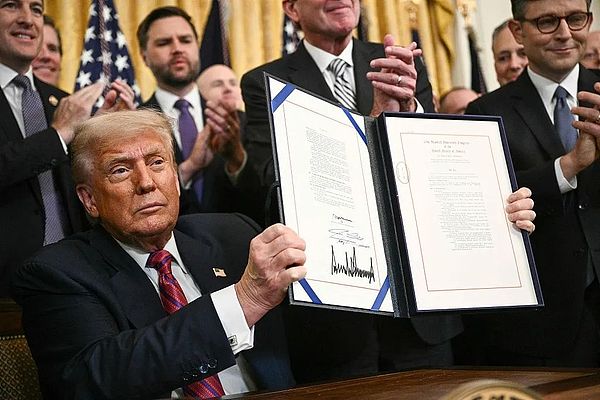On the 18th local time, US President Trump officially signed the "Guidance and Establishment of the United States Stablecoin National Innovation Act" (hereinafter referred to as the "Genius Act") at the White House, marking the first time that the United States has formally established a regulatory framework for digital stablecoins.
Trump said that stablecoins will increase demand for U.S. Treasuries, lower U.S. interest rates and ensure the dollar's global reserve currency status.
Since the start of his second term, Trump has launched a number of initiatives to support cryptocurrencies. The United States has recently accelerated the legislative process of the "Genius Act". What impact will it have on the United States?

△On July 18, Trump officially signed the Genius Act.
Speed up the legislative process
On June 17, the U.S. Senate passed the Genius Act by a vote of 68 to 30, marking the first time the Senate has approved major cryptocurrency legislation. On July 17, the U.S. House of Representatives voted to pass three bills on stablecoins and other encrypted digital currencies, including the "Guidance and Establishment of the U.S. Stablecoin National Innovation Act", the "Digital Asset Market Clarity Act", and the "Anti-Central Bank Digital Currency Surveillance National Act".
On July 18, U.S. President Trump signed the "Genius Act" and called it "one of the greatest changes in financial technology since the birth of the Internet." At the same time, he reiterated that "central bank digital currency will never be allowed to be established in the United States."
Three Questions about US Cryptocurrency-Related Bills
Cryptocurrency is generated by an algorithm and adopts a decentralized model. Holders update the quantity according to the algorithm. Main cryptocurrencies include Bitcoin, stablecoins, etc..
Stablecoins are different from Bitcoin. Its price is relatively stable and is usually pegged to the US dollar at a 1:1 ratio. After the "Genius Act" is signed and implemented, stablecoins will be required to be supported by liquid assets such as the US dollar or US short-term Treasury bonds, and issuers will be required to disclose the details of stablecoin reserves every month.
Currently, the two largest stablecoins in the world are Tether (USDT) and USDC, and their combined market value accounts for about 90% of the total market value.
Stablecoins were first launched in 2014. In 2020, the global stablecoin market value was only $20 billion, which was in the initial stage of the market. Since then, stablecoins have entered a stage of rapid growth supported by two major driving forces -
On the one hand, in cryptocurrency transactions, more than 90% of Bitcoin transactions are settled through USDT/USDC, making it a "crypto-dollar standard";
On the other hand, in emerging market countries, stablecoins have become a "digital safe-haven asset" for the civilian class, accounting for as much as 72% of the cryptocurrency trading volume in these countries.
According to statistics from the cryptocurrency data provider Bihu, the stablecoin market size is currently about $247 billion. U.S. Treasury Secretary Benson said that the stablecoin market is expected to grow to $3.7 trillion by 2030.
Experts pointed out that in the process of digital currency development, the value and influence of the US dollar have been greatly impacted. The United States hopes to promote the stable currency model, give full play to the existing and strong advantages of the US dollar, and maintain and enhance its influence in the field of stable currency and digital currency. Trump and some US officials have proposed that the pressure on US debt in the future may be reduced by issuing stable currency. From the fundamental purpose, the US government promotes stable currency, hoping to continue to maintain its dominance in the global monetary system and payment system, further influence the future global monetary and payment system, and maintain the competitiveness of the United States.
Experts analyzed that the current influence of the US dollar in the world is based on the international economic order after World War II, and has formed the international influence of the US dollar itself. The measures currently taken by the Trump administration show that it does not recognize the US trade deficit and wants to maintain a surplus or balance. Maintaining a surplus means that no more US dollars will flow into the international market through trade, which will obviously restrict the global use of the US dollar.
Whether a currency or a payment method can be favored is not only a matter of cost, but also the credibility behind the currency.
Experts believe that in the future, whether the United States can assume necessary responsibilities for the world, fulfill its commitments, and maintain the stability of the global trade economy, rather than intervening in international economic and trade relations through sanctions and long-arm jurisdiction, is very important for the development of stablecoins. If these cannot be done, and the dollar is simply replaced by another way of expression without changing the way the dollar itself is determined, then both the dollar and the corresponding stablecoin may find it difficult to gain global and broader support in the future.
The bill is controversial in the United States
Analysts believe that the Genius Act will pave the way for American banks to independently issue digital assets after it becomes law. Wall Street executives such as JPMorgan Chase and Citigroup are eager to open up digital asset businesses, while Bank of America CEO Brian Moynihan reminds that it is not clear how much digital currency will be in demand. The Genius Act has also been questioned and opposed by some people from both parties. Some Democrats believe that the bill fails to provide adequate protection for consumers, national security or financial stability, and accuse the Trump family of having links with cryptocurrencies. Republicans who hold opposing views believe that the bill does not follow an executive order signed by Trump in January this year, which includes a ban on the promotion of central bank digital currencies.  Anais
Anais




